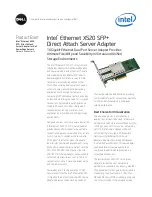
3
Features
Benefits
General
Intel® 82599 10 Gigabit Ethernet Controller
• Industry-leading, energy-efficient design for next-generation 10 Gigabit performance and multi-core
processors
Low-profile
• Enables higher bandwidth and throughput from standard and low-profile PCIe slots and servers
Load balancing on multiple CPUs
• Increases performance on multi-processor systems by efficiently balancing network loads across CPU
cores when used with Receive-Side Scaling (RSS) from Microsoft or Scalable I/O on Linux*
iSCSI remote boot support
• Provides centralized storage area network (SAN) management at a lower cost than other iSCSI
solutions
Support for most network operating systems (NOS)
• Enables widespread deployment
RoHS-compliant
2
• Complies with the European Union directive 2002/95/EC to reduce the use of hazardous materials
Intel® PROSet Utility for Windows* Device Manager
• Provides point-and-click management of individual adapters, advanced adapter features, connection-
teaming, and virtual local area network (VLAN) configuration
Time Sync (IEEE 1588, 802.1as)
• Lets networked Ethernet equipment synchronize internal clocks according to a network master clock;
endpoint can then acquire an accurate estimate of the master time by compensating for link latency
I/O Features for Multi-core Processor Servers
Intel® QuickData Technology
• DMA Engine: enhances data acceleration across the platform (network, chipset, processor), lowering
CPU usage
• Direct Cache Access (DCA): enables the adapter to pre-fetch the data from memory, avoiding cache
misses and improving application response time
MSI-X support
• Minimizes the overhead of interrupts
• Allows load-balancing of interrupt handling between multiple cores/CPUs
Low latency interrupts
• Based on the sensitivity of the incoming data, the adapter can bypass the automatic moderation of
time intervals between the interrupts
Header splits and replication in receive
• Helps the driver focus on the relevant part of the packet without the need to parse it
Multiple Queues: 16 queues per port
• Network packet handling without waiting or buffer overflow providing efficient packet prioritization
Tx/Rx IP, SCTP, TCP, and UDP checksum offloading (IPv4,
IPv6) capabilities
• Lower processor usage
• Checksum and segmentation capability extended to new standard packet type
Tx TCP segmentation offload (IPv4, IPv6)
• Increased throughput and lower processor usage
• Compatible with large send off-load feature (in Microsoft Windows* Server OSs)
Receive and Transmit Side Scaling for Windows
environment and Scalable I/O for Linux* environments
(IPv4, IPv6, TCP/UDP)
• This technology enables the direction of the interrupts to the processor cores in order to improve the
CPU utilization rate
LinkSec
• IEEE spec: 802.1ae
• Layer 2 data protection that provides encryption and authentication ability between two individual
devices (routers, switches, etc.)
• LinkSec is designed into the network adapter hardware. These adapters are prepared to provide
LinkSec functionality when the ecosystem is ready to support this new technology
Virtualization Features
VMDq
• Offloads the data-sorting functionality from the Hypervisor to the network silicon, improving data
throughput and CPU usage
• Provides QoS feature on the Tx data by providing round-robin servicing and preventing head-of-line
blocking
• Sorting based on MAC addresses and VLAN tags
Next-Generation VMDq1 (64 queues per port)
• Enhanced QoS feature by providing weighted round-robin servicing for the Tx data
• Provides loopback functionality, where data transfer between the virtual machines within the same
physical server need not go out to the wire and come back in, improving throughput and CPU usage
• Supports replication of multicast and broadcast data
PC-SIG SR-IOV Implementation (64 virtual functions per
port)
• Provides an implementation of the PCI-SIG standard for I/O Virtualization. The physical configuration of
each port is divided into multiple virtual ports. Each virtual port is assigned to an individual virtual ma-
chine directly by bypassing the virtual switch in the Hypervisor, resulting in near-native performance.
• Integrated with Intel® VTI for Directed I/O (VT-d) to provide data protection between virtual machines
by assigning separate physical addresses in the memory to each virtual machine
IPv6 Offloading
• Checksum and segmentation capability extended to the new standard packet type
Advanced packet filtering
• 24 exact-matched packets (unicast or multicast)
• 4096-bit hash filter for unicast and multicast frames
• Lower processor usage
• Promiscuous (unicast and multicast) transfer mode support
• Optional filtering of invalid frames
VLAN support with VLAN tag insertion, stripping and
packet filtering for up to 4096 VLAN tags
• Ability to create multiple VLAN segments























